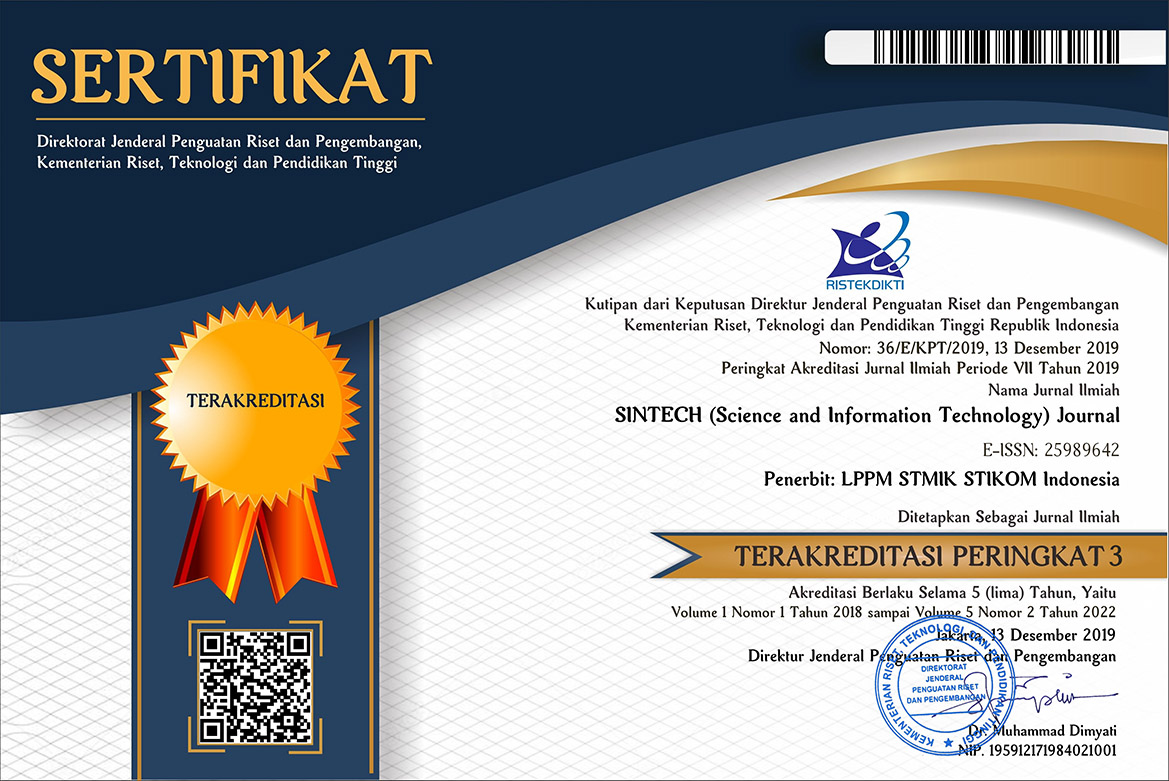Implementasi Steganografi Gambar Menggunakan Algoritma Generative Adversarial Network
DOI:
https://doi.org/10.31598/sintechjournal.v6i1.1258Keywords:
Steganography Steganalysis, Image Processing, Generative Adversarial NetworkAbstract
Abstract
In the era of information technology, it is very important to protect data and information so that irresponsible parties do not misuse it. One technique for securing data is steganography. Steganography is a technique of hiding messages in a medium. One of the media for hiding messages is pictures. However, steganography techniques can still be detected by steganalysis techniques. Steganalysis is a technique for analyzing hidden messages in steganography. Therefore this study applies image processing techniques with the Generative Adversarial Network algorithm model, which aims to manipulate images so that steganalysis techniques cannot detect hidden messages. Proof of the results of applying the Generative Adversarial Network algorithm using a web-based application containing message hiding and extraction functions. The results obtained are that the Generative Adversarial Network algorithm can be applied to create mock objects, and images can revive based on training data which is a model for how the algorithm works. In addition, the results of testing the Generative Adversarial Network algorithm were successfully applied to image steganography which functions to prevent steganalysis techniques from trying to detect messages in images. Future research is expected to be able to select steganographic images other than the results from the training data model according to the original size chosen randomly according to the selection of the user.
Downloads
References
I. A. Huda, “Perkembangan Teknologi Informasi Dan Komunikasi (Tik) Terhadap Kualitas Pembelajaran Di Sekolah Dasar,” J. Pendidik. dan Konseling, vol. 2, no. 1, pp. 121–125, 2020, doi: 10.31004/jpdk.v1i2.622.
A. I. Mutiasari, “Perkembangan Industri Perbankan Di Era Digital,” J. Ekon. Bisnis Dan Kewirausahaan, vol. 9, no. 2, pp. 32–41, 2020, doi: 10.47942/iab.v9i2.541.
N. Nukman, Y. Prayudi, and F. Yudha, “Pengembangan Framework Digital Forensics Investigation (FDFI) Pada Sosial Media Dengan Metode System Development Life Cycle (SDLC),” JATISI (Jurnal Tek. Inform. dan Sist. Informasi), vol. 9, no. 3, pp. 1852–1860, 2022, doi: 10.35957/jatisi.v9i3.2151.
B. J. Simbolon, “Steganografi Penyisipan Pesan Pada File Citra Dengan Menggunakan Metode LSB (Least Significant Bit),” J. Nas. Komputasi dan Teknol. Inf., vol. 4, no. 1, pp. 1–6, 2021, doi: 10.32672/jnkti.v4i1.2656.
Y. Aditya, A. Pratama, and A. Nurlifa, “Studi pustaka untuk steganografi dengan beberapa metode,” Semin. Nas. Apl. Teknol. Inf. 2010 (SNATI 2010), vol. 2010, no. Snati, pp. 32–35, 2010.
M. B. Akbar and E. V Haryanto, “Aplikasi Steganografi dengan Menggunakan Metode F5,” … Sist. Inf. dan Teknol. …, no. April 2013, pp. 165–178, 2015, [Online]. Available: https://ejurnal.dipanegara.ac.id/index.php/jusiti/article/view/58.
S. Gallagher, “Steganography: how al-Qaeda hid secret documents in a porn video,” arstechnica.com, 2012. https://arstechnica.com/information-technology/2012/05/steganography-how-al-qaeda-hid-secret-documents-in-a-porn-video/ (accessed May 20, 2022).
A. Hafiz, “Steganografi Berbasis Citra Digital Untuk Menyembunyikan Data Menggunakan Metode Least Significant Bit (Lsb),” J. Cendikia, vol. 17, no. 1 April, pp. 194–198, 2019, [Online]. Available: https://jurnal.dcc.ac.id/index.php/JC/article/view/201.
Z. A. I. Niswati, “STEGANOGRAFI BERBASIS LEAST SIGNIFICANT BIT ( LSB )ZA’IMATUN, N.; BIT, Steganografi Berbasis Least Significant. Steganografi Berbasis Least Significant Bit (LSB) Untuk Menyisipkan Gambar Ke Dalam Citra Gambar,” vol. 5, no. 2, pp. 181–191, 1979, [Online]. Available: https://journal.lppmunindra.ac.id/index.php/Faktor_Exacta/article/download/194/185.
M. Hadi and N. U. R. Aini, “Gambar Menggunakan Metode Eof Dengan Enkripsi Rsa Berbasis Android,” vol. 2, pp. 131–136, 2019.
H. M. Damayanti, Yudo Bismo Utomo, “Penerapan Teknik Steganalysis Menggunakan Metode Chi Square Attack Pada Stego Image Berformat Jpeg Berbasis Android,” J. Sist. Telekomun. Elektron. Sist. Kontrol Power Sist. Komput., vol. 1, no. 1, pp. 51–58, 2021, [Online]. Available: https://media.neliti.com/media/publications/344687-implementation-of-steganalysis-technique-2f679bb4.pdf.
W. Hidayat, “Mendeteksi Keberadaan Pesan Tersembunyi dalam Citra Digital dengan Blind Steganalysis,” pp. 77–81, 2011.
R. Siringoringo, “Analisis Psnr Pada Steganografi Least Significant Bit Dengan Pesan Terenkripsi Advanced Encription System,” J. Method., vol. 2, no. 1, pp. 124–130, 2016.
A. R. Kelrey, Y. Prayudi, and E. Ramadhani, “Identifikasi Source Image Menggunakan Pendekatan Forensic Similarity pada Image Forensik,” JATISI (Jurnal Tek. Inform. dan Sist. Informasi), vol. 9, no. 3, pp. 1873–1883, 2022, doi: 10.35957/jatisi.v9i3.2483.
A. Zein, “Manipulasi Gambar Menggunakan Jaringan Adversarial Siklus-Konsisten,” Sainstech J. Penelit. dan Pengkaj. Sains dan Teknol., vol. 29, no. 2, pp. 1–5, 2019, doi: 10.37277/stch.v29i2.330.
A. A. Praramadhan and G. E. Saputra, “Cycle Generative Adversarial Networks Algorithm With Style Transfer For Image Generation,” pp. 1–12, 2021, [Online]. Available: http://arxiv.org/abs/2101.03921.
H. Shi, J. Dong, W. Wang, and Y. Qian, “SSGAN: Secure Steganography Based on Generative Adversarial Networks Haichao,” Pacific Rim Conf. Multimed. Adv. Multimed. Inf. Process., vol. PCM 2017, pp. 534–544, 2017, [Online]. Available: http://link.springer.com/10.1007/978-3-642-34778-8--------.
J. Qin, J. Wang, Y. Tan, H. Huang, X. Xiang, and Z. He, “Coverless image steganography based on generative adversarial network,” Mathematics, vol. 8, no. 9, pp. 1–11, 2020, doi: 10.3390/MATH8091394.
R. W. P. Pamungkas, Rakhmi Khalida, and Siti Setiawati, “Pembuatan Gambar Sintesis Dari Deksripsi Teks Dengan Algoritma Generative Adversarial Network,” Aisyah J. Informatics Electr. Eng., vol. 2, no. 2, pp. 111–114, 2020, doi: 10.30604/jti.v2i2.31.
I. B. G. Anandita, I. G. A. Gunadi, and G. Indrawan, “Analisis Kinerja Dan Kualitas Hasil Kompresi Pada Citra Medis Sinar-X Menggunakan Algoritma Huffman, Lempel Ziv Welch Dan Run Length Encoding,” SINTECH (Science Inf. Technol. J., vol. 1, no. 1, pp. 7–15, 2018, doi: 10.31598/sintechjournal.v1i1.179.
F. Liantoni and A. Santoso, “Perbaikan Kontras Citra Mammogram Pada Klasifikasi Kanker Payudara Berdasarkan Fitur Gray-Level Co-Occurrence Matrix,” SINTECH (Science Inf. Technol. J., vol. 3, no. 1, pp. 46–51, 2020, doi: 10.31598/sintechjournal.v3i1.528.
I. G. R. M. Putra, M. W. A. Kesiman, G. A. Pradnyana, and I. M. D. Maysanjaya, “Identifikasi Citra Ukiran Ornamen Tradisional Bali Dengan Metode Multilayer Perceptron,” SINTECH (Science Inf. Technol. J., vol. 4, no. 1, pp. 29–39, 2021, doi: 10.31598/sintechjournal.v4i1.552.
M. Marudin and W. Windarto, “Implementasi Steganografi Least Significant Bit (Lsb) Pada Aplikasi Berbasis Desktop Di Pengembang Properti Bsa Land,” Skanika, vol. 4, no. 2, pp. 57–62, 2021, doi: 10.36080/skanika.v4i2.2434.
L. Chen, R. Wang, D. Yan, and J. Wang, “Learning to Generate Steganographic Cover for Audio Steganography Using GAN,” IEEE Access, vol. 9, pp. 88098–88107, 2021, doi: 10.1109/ACCESS.2021.3090445.
Z. Fu, F. Wang, and X. Cheng, “The secure steganography for hiding images via GAN,” Eurasip J. Image Video Process., vol. 2020, no. 1, 2020, doi: 10.1186/s13640-020-00534-2.
A. Anharudin, S. Siswanto, and R. M. Syakira, “Rancang Bangun Data Storage System berbasis Web Dengan Metode Extreme Programming,” J. Tekno Kompak, vol. 16, no. 1, p. 123, 2022, doi: 10.33365/jtk.v16i1.1454.
E. B. Setiawan and A. Setiyadi, “Model Sistem Rekomendasi Untuk Menciptakan Wirausahawan Baru Menggunakan Metode Saw Dan Teknologi Web,” vol. 4, no. 1, pp. 99–105, 2021, [Online]. Available: https://doi.org/10.31598.
H. H. BAHAR, “Perancangan Aplikasi Pemilihan Rumah Kos di Sekitar Universitas Mercubuana dengan metode SAW Berbasis Website,” 2022, [Online]. Available: https://repository.mercubuana.ac.id/69145/%0Ahttps://repository.mercubuana.ac.id/69145/1/01 Cover.pdf.
Haviluddin, “Memahami Penggunaan UML ( Unified Modelling Language ),” Memahami Pengguna. UML (Unified Model. Lang., vol. 6, no. 1, pp. 1–15, 2011, [Online]. Available: https://informatikamulawarman.files.wordpress.com/2011/10/01-jurnal-informatika-mulawarman-feb-2011.pdf.
Downloads
Published
How to Cite
Issue
Section
License
Copyright (c) 2023 Khairunnisak, Gilang Miftakhul Fahmi, Didit Suhartono

This work is licensed under a Creative Commons Attribution-NonCommercial-ShareAlike 4.0 International License.
Copyright in each article belongs to the author.
- The authors admit that SINTECH Journal as a publisher who published the first time under
 Attribution-NonCommercial-ShareAlike 4.0 International (CC BY-NC-SA 4.0) License.
Attribution-NonCommercial-ShareAlike 4.0 International (CC BY-NC-SA 4.0) License. - Authors can include writing separately, regulate distribution of non-ekskulif of manuscripts that have been published in this journal into another version (eg sent to respository institution author, publication into a book, etc.), by recognizing that the manuscripts have been published for the first time in SINTECH Journal















1.png)




